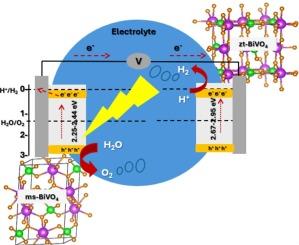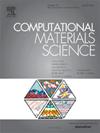Understanding the photocatalytic activity of bismuth vanadate phases for solar water splitting: A DFT-based comparative study
IF 3.1
3区 材料科学
Q2 MATERIALS SCIENCE, MULTIDISCIPLINARY
引用次数: 0
Abstract
Bismuth Vanadate (BiVO4) is a promising candidate for solar water splitting due to its excellent photocatalytic properties. The monoclinic scheelite structure, in particular, is noted for its high-water oxidation activity and has an energy gap of 2.4–2.5 eV. Recently, other phases, especially the tetragonal zircon phase, have also demonstrated interesting photocatalytic properties. Therefore, our study aims to provide a direct comparison of the photocatalytic capabilities of different BiVO4 structures. To do so, we employed a comprehensive approach to understand the photocatalytic activity of various BiVO4 crystalline structures, focusing on their structural, electronic, and optical properties using density functional theory (DFT). To describe the electronic properties more accurately, we used corrected density functional theory. We investigated the impact of on-site Coulomb interaction on the structural and electronic properties of BiVO4. Our results indicate that the monoclinic scheelite structure has a narrow band gap (2.44 eV), light hole effective masses, the largest dipole moment, stronger visible light absorption, and a suitable valence band edge position. These features contribute to its excellent photocatalytic activity, making it a strong candidate for use as a photoanode in photoelectrochemical cells. Moreover, the tetragonal zircon phase exhibits light electron effective masses compared to the scheelite phases, along with suitable conduction and valence band edge positions and a direct band gap. These properties suggest its potential application as a photocathode for solar water splitting. Our findings provide valuable insights into enhancing the overall performance of BiVO4 for solar water splitting applications, highlighting the distinct advantages of both the monoclinic scheelite and tetragonal zircon phases.

了解用于太阳能水分离的钒酸铋相的光催化活性:基于 DFT 的比较研究
钒酸铋(BiVO4)具有出色的光催化特性,是太阳能水分离的理想候选材料。尤其是单斜白钨矿结构,因其高水氧化活性和 2.4-2.5 eV 的能隙而著称。最近,其他相,特别是四方锆石相,也表现出了有趣的光催化特性。因此,我们的研究旨在直接比较不同结构的 BiVO4 的光催化能力。为此,我们采用了一种全面的方法来了解各种 BiVO4 晶体结构的光催化活性,重点是利用密度泛函理论(DFT)研究它们的结构、电子和光学特性。为了更准确地描述电子特性,我们使用了修正密度泛函理论。我们研究了现场库仑相互作用对 BiVO4 结构和电子特性的影响。结果表明,单斜白钨矿结构具有较窄的带隙(2.44 eV)、较轻的空穴有效质量、最大的偶极矩、较强的可见光吸收能力以及合适的价带边缘位置。这些特点使其具有出色的光催化活性,成为光电化学电池光阳极的有力候选材料。此外,与白钨矿相相比,四方锆石相具有较轻的电子有效质量,以及合适的导带和价带边缘位置和直接带隙。这些特性表明,它有可能用作太阳能水分离的光电阴极。我们的研究结果为提高 BiVO4 在太阳能水分离应用中的整体性能提供了宝贵的见解,突出了单斜白钨矿相和四方锆石相的独特优势。
本文章由计算机程序翻译,如有差异,请以英文原文为准。
求助全文
约1分钟内获得全文
求助全文
来源期刊

Computational Materials Science
工程技术-材料科学:综合
CiteScore
6.50
自引率
6.10%
发文量
665
审稿时长
26 days
期刊介绍:
The goal of Computational Materials Science is to report on results that provide new or unique insights into, or significantly expand our understanding of, the properties of materials or phenomena associated with their design, synthesis, processing, characterization, and utilization. To be relevant to the journal, the results should be applied or applicable to specific material systems that are discussed within the submission.
 求助内容:
求助内容: 应助结果提醒方式:
应助结果提醒方式:


